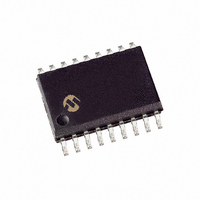MCP2140A-I/SO Microchip Technology, MCP2140A-I/SO Datasheet - Page 48

MCP2140A-I/SO
Manufacturer Part Number
MCP2140A-I/SO
Description
IC IRDA CONTROLLR DTE/DCE 18SOIC
Manufacturer
Microchip Technology
Specifications of MCP2140A-I/SO
Package / Case
18-SOIC (7.5mm Width)
Controller Type
IRDA Standard Protocol Stack Controller
Interface
UART
Voltage - Supply
3 V ~ 5.5 V
Current - Supply
2.2mA
Operating Temperature
-40°C ~ 125°C
Mounting Type
Surface Mount
Product
Controller Area Network (CAN)
Maximum Operating Temperature
+ 85 C
Minimum Operating Temperature
- 40 C
Mounting Style
SMD/SMT
Ic Function
Standard Protocol Stack Controller
Brief Features
Includes UART-to-IrDA Standard Encoder/decoder Functionality, Infrared Supported
Supply Voltage Range
2V To 5.5V
Rohs Compliant
Yes
Lead Free Status / RoHS Status
Lead free / RoHS Compliant
For Use With
MCP2140DM-TMPSNS - BOARD DEMO FOR MCP2140
Lead Free Status / Rohs Status
Lead free / RoHS Compliant
Available stocks
Company
Part Number
Manufacturer
Quantity
Price
Company:
Part Number:
MCP2140A-I/SO
Manufacturer:
MICROCHIP
Quantity:
12 000
Part Number:
MCP2140A-I/SO
Manufacturer:
MICROCHIP/微芯
Quantity:
20 000
MCP2140A
B.1
When two IrDA standard compatible devices come into
range, they must first recognize each other. The basis
of this process is that one device has some task to
accomplish and the other device has a resource
needed to accomplish this task. One device is referred
to as a Primary Device and the other is referred to as a
Secondary Device. This distinction between Primary
Device and Secondary Device is important. It is the
responsibility of the Primary Device to provide the
mechanism to recognize other devices. So the Primary
Device must first poll for nearby IrDA standard
compatible devices. During this polling, the default
baud rate of 9600 baud is used by both devices.
For example, if you want to print from an IrDA equipped
laptop to an IrDA printer, utilizing the IrDA standard
feature, you would first bring your laptop in range of the
printer. In this case, the laptop is the one that has
something to do and the printer has the resource to do
it. The laptop is called the Primary Device (Client) and
the printer is the Secondary Device (Server). Some
data-capable cell phones have IrDA standard infrared
ports. If you used such a cell phone with a Personal
Digital Assistant (PDA), the PDA that supports the IrDA
standard feature would be the Primary Device and the
cell phone would be the Secondary Device.
When a Primary Device polls for another device, a
nearby Secondary Device may respond. When a
Secondary Device responds, the two devices are
defined to be in the Normal Disconnect Mode (NDM)
state. NDM is established by the Primary Device broad-
casting a packet and waiting for a response. These
broadcast packets are numbered. Usually 6 or 8
packets are sent. The first packet is number 0, the last
packet is usually number 5 or 7. Once all the packets
are sent, the Primary Device sends an ID packet, which
is not numbered.
The Secondary Device waits for these packets and
then responds to one of the packets. The packet
responds to determines the “timeslot” to be used by the
Secondary Device. For example, if the Secondary
Device responds after packet number 2, then the
Secondary Device will use timeslot 2. If the Secondary
Device responds after packet number 0, then the
Secondary Device will use timeslot 0. This mechanism
allows the Primary Device to recognize as many
nearby devices as there are timeslots. The Primary
Device will continue to generate timeslots and the
Secondary Device should continue to respond, even if
there’s nothing to do.
DS22050A-page 48
Note:
Normal Disconnect Mode (NDM)
In the parlance of software development,
the Primary Device is called a Client and
the Secondary Device is called a Server.
During NDM, the MCP2140A handles all responses to
the
communication with the Host Controller. The Host Con-
troller is inhibited by the CTS signal of the MCP2140A
from sending data to the MCP2140A.
Note 1: The MCP2140A can only be used to
Primary
2: The MCP2140A supports a system with
3: The MCP2140A always responds to
4: If another Secondary Device is nearby,
implement a Secondary Device.
only one Secondary Device having
exclusive use of the IrDA standard
infrared link (known as “point-to-point”
communication).
packet number 0. This means that the
MCP2140A will always use timeslot 0.
the Primary Device may fail to recognize
the MCP2140A, or the Primary Device
may not recognize either of the devices.
Device
© 2007 Microchip Technology Inc.
(Figure
B-1)
without
any

















